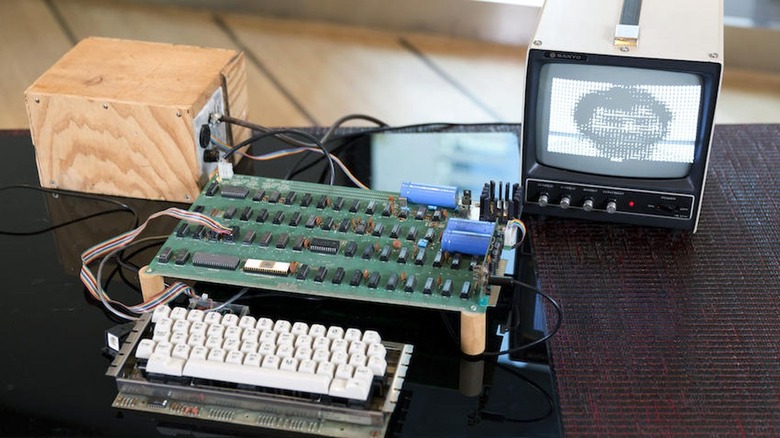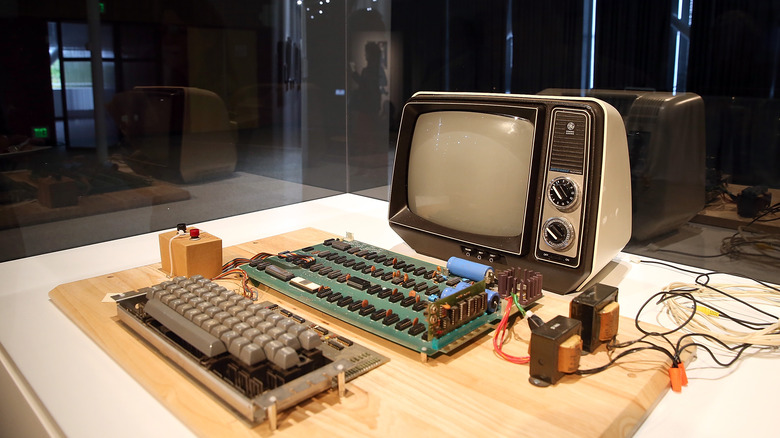This Apple-1 Computer Is The Most Expensive In The World
In 1976, the United States was in the midst of its bicentennial, a months-long celebration recognizing the 200th anniversary of the signing of the Declaration of Independence. George Lucas was feverishly working on a space fantasy movie called "Star Wars." And two Steves — Wozniak and Jobs — were in a Palo Alto, California, garage (or Jobs' sister's bedroom, depending on who you talk to) hand-building the very first products for what would become the technology juggernaut known as Apple.
Wozniak unveiled his first hand-built prototype Apple computer during a Menlo Park Homebrew Computer Club meeting in July of that same year. Jobs immediately realized it was something that needed to be sold in mass to the general public. Jobs sold his Volkswagen van and Wozniak his HP-65 calculator, and the two went into business together as the Apple Computer Company.
With grandiose plans in mind, Jobs spoke with fellow Homebrew Computer Club member Paul Terrell, who coincidently owned The Byte Shop in Mountain View, California. After their talk, Terrell bought 50 Apple-1 computers as long as they weren't just kits but fully assembled and ready to use. Over the next ten months, Wozniak and Jobs, with the help of Patty Jobs and Daniel Kottke, designed, built, and tested 200 Apple-1 computers, which they then sold for $666.66 each (Wozniak loved repeating numbers).
Fifty went to Terrell, who sold them at The Byte Shop, now regarded as one of the world's first personal computers stores. It also made the Apple-1 "one of the first 'personal' computers which did not require soldering by the end user."
How about them apples?
While it might have been a "working computer," it certainly wasn't complete, and it looked nothing like what we expect a fully functioning computer to look like today. The first Apple-1s were basically just a fully assembled circuit board with 60 or so microchips. The end user still had to provide the "case, power supply transformers, power switch, ASCII keyboard, and composite video display" (via Jeffry Norman's History of Information). Thankfully, the Apple-1 was selling at a computer hobbyist store where someone could purchase all of those things separately — American consumerism at its finest.
Over the years, several computers from the first batch of 200 Apple-1s have sold at auction. Each is unique because, after their initial sale, they were customized by each owner. In November 2021, the "Chaffey College" Apple-1, named because it was initially purchased by a professor at the college, sold for $400,000. In March 2020, RR Auction sold one for $458,711. In May 2019, Christie's sold one for $459,000. Christie's reportedly sold one signed by Steve Wozniak in 2013 for $387,750, and Charitybuzz sold another for $815,000 in August 2016.
Yet, none of those were the priciest Apple on the tree.
In October 2014, the Henry Ford Museum paid $905,000 for what amounted to a "vintage keyboard with pre-7400-series military specification chips, a vintage Sanyo monitor, a custom power supply in a wooden box, as well as two vintage tape-decks." After what was described by Bonhams as "fierce competition with a bidder on the telephone," the final sale price ended at nearly twice the estimate going into the auction. That kind of money puts a whole new spin on the idiom, "How 'bout them apples?"

